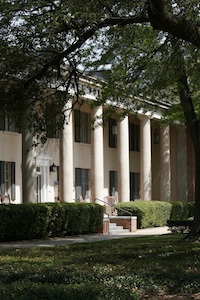8 Tips for Wireless in the Residence Halls

Scott Merritt, director of information technology for Centenary College of Louisiana |
The signs are all around us. Technological advancements in recent years have brought about an unprecedented blizzard of new mobile devices such as notebooks, tablet PCs, smart phones and gaming consoles in the marketplace. Like many students across the country, the students of Centenary College of Louisiana are bringing more devices to school. They have come to expect seamless wireless connectivity not just in the classrooms but also in the residence halls.
In close communication with the Centenary community, our IT department quickly came to the realization that providing wireless connectivity for our student body ranked as one of our top IT priorities. In the summer of 2009, we began installing wireless infrastructure in the residence halls. By fall 2009, we welcomed approximately 600 new and returning student residents who were greeted with wireless connectivity for all their devices, and, with that, the college and our students gained entry into the modern era of mobile connectivity.
Our deployment couldn't have gone better. If you are an IT director at a higher educational institution and are considering wireless in the residence halls, below are eight tips for successful wireless implementation, based on our experience.
1. Plan for Now and the Future
Once you decide to install a wireless network in the residence halls, keep in mind to plan not just for the incoming group of student residents, but also to plan a network that will scale as new technologies advance and bandwidth needs grow years into the future.
At Centenary's residence halls just a few years ago, Netflix was a fringe service used only by a handful of our student residents, and no one had even heard of the iPad. Thankfully, our decision to install an expandable WiFi network before our students began embracing video-on-demand services and mobile devices en masse enabled us to build a solid foundation to satisfactorily support their growing connectivity needs.
2. In-House or Outsource?
Every higher education institution is different, and some of you may decide to set up the wireless network for your student residents through in-house staffers and resources. Centenary decided to leverage our residential networking (resnet) partner, Apogee, based on technological expertise, cost savings and the availability of a dedicated team to ensure efficient installation, support and expansion.
Our IT department was and still is a lean team of five, with expertise in databases, personal computers, and server administration. We were really not fully staffed to keep up with bandwidth demands or to provide residential networking, wired or wireless, in the residence halls. I still remember how quickly the troubleshooting phone calls stopped as soon as we deployed managed resnet and how that simple decision empowered and freed up my team to work with Centenary's administrators to focus on the more strategic and academic IT issues of our school.
3. Cost Considerations
Consider the most cost-effective strategy for arriving at your ultimate goal. In weighing the costs associated through doing this ourselves versus through our managed resnet provider, Centenary was able to save approximately $1.4 million over the life of the contract. As our partner assumed the initial investment for both equipment and installation, Centenary was able to defer up-front capital expenditures, yet promptly set up a wireless network that scales as technologies and student needs evolve.

T.L. James Residence Hall, Centenary College of Louisiana |
4. Consistent, Close Communication with Stakeholders
Consistent and close communication with stakeholders of your higher education institution is an important measurement of success for installing a wireless network in the residence halls. When tradeoffs need to be made--for instance, increased access point placement over building aesthetics--it's important that all stakeholders understand the issue, the reasoning, and the benefit in order to sign off on the decision. It's also critical to maintain regular communication with the stakeholders most directly affected--the students. It's their direct and ongoing feedback that enables the school to ensure the best coverage throughout all buildings.
Resident students will also benefit from regular communications. Our IT department reached out to students in the following ways: e-mail communications, Web site updates, and the distribution of IT pamphlets updating students on the project's progress.
5. Technical Considerations
Before WiFi deployment begins, the groundwork must be laid with thorough research and a comprehensive site survey. The Centenary WiFi network was planned after considerable research into historical data on student bandwidth usage and trends.
We conducted extensive testing of our residence halls for the best locations for access points and planned for the integration of new wireless networking equipment with the existing network. One example of our technological upgrades is the provisioning of up to 10 IP addresses for each of our students instead of the less than one IP address per student from previous years. With the proliferation of mobile computing devices such as smart phones and iPads, students often need multiple addresses simultaneously--and a small subset connect a disproportionate number of devices to the network.
6. Design WiFi with Building Architecture in Mind
Many college residence halls are housed within century-old buildings. Many are architectural landmarks, visually appealing, but wirelessly challenging. The thick walls of the building present challenges as they attenuate RF signals and weaken wireless coverage. Understanding this, it is important to plan to have many more access points in close proximity to the residents than the number you might install for a modern office building, for example.
7. Ensure Optimum Security
It's wise to install a WiFi network that guards against intrusions, identity theft, and future virus attacks. One of the most important things we did was to separate out the student residential network from the administrative network. This allowed us to isolate the source of security breaches much faster and also prevented any unanticipated viruses from bleeding into the other network.
8. Provide Ongoing Support
In providing connectivity in the residence halls, it is important to take into consideration our students' need for technical support. My IT team keeps office hours, but our resident students sometimes require wired and wireless Internet access during the wee hours of the morning. Through our resnet provider, Centenary provides 24/7/365 phone support to all residents, ensuring that they're always able to connect their network-capable devices.
The student residents of Centenary College of Louisiana are a truly connected, intelligent and technologically savvy cohort. We are proud to be able to provide the most advanced wireless technologies and support so we can provide them with the optimum IT environment and educational experiences that they deserve.